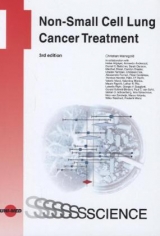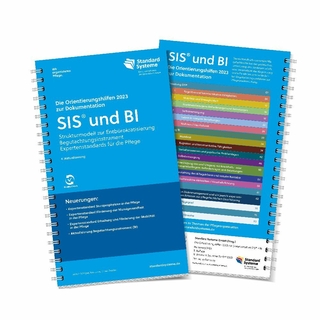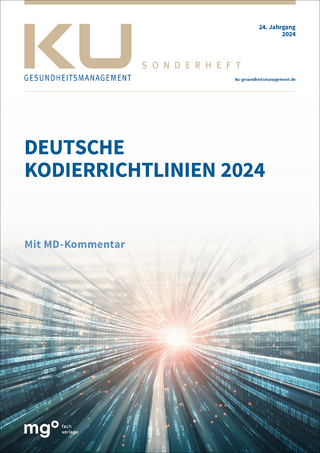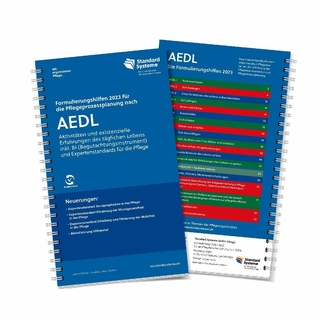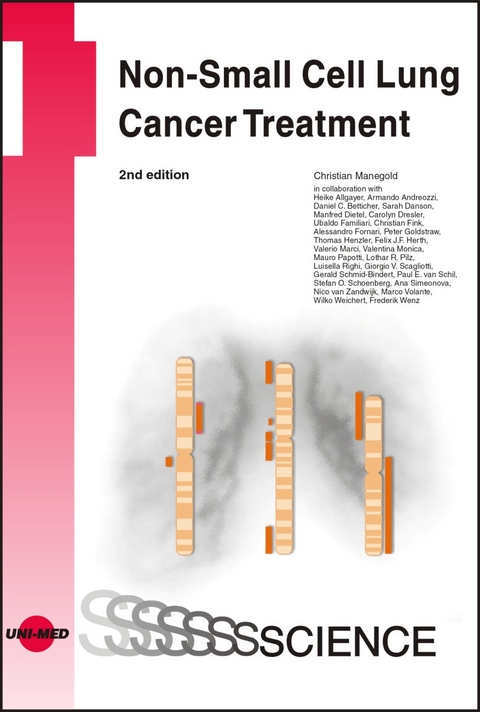
Non-Small Cell Lung Cancer Treatment
UNI-MED (Verlag)
978-3-8374-1256-7 (ISBN)
- Titel erscheint in neuer Auflage
- Artikel merken
The present second edition emphasizes the need for interdisciplinary communication and interdisciplinary treatment concepts to improve survival of patients with this malignancy.
The various contributions provide information about the increasing role of biologic tumor characteristics, novel diagnostic and therapeutic standards (interventional bronchoscopy, surgery, radiotherapy, chemotherapy), and focus attention to the several unresolved issues that will need to be addressed in the future.
1.The Changing Epidemic of Lung Cancer18
1.1.Histological variability21
1.2.References23
2.Establishing a Tumor Tissue Bank: An Interdisciplinary Challenge25
2.1.Introduction25
2.2.Requirements for establishing and conducting a tumor tissue bank25
2.2.1.Personnel25
2.2.2.The structural and technical requirements25
2.2.3.Ethics26
2.3.Planning of the tumor bank27
2.4.Conducting a tumor tissue bank in practice27
2.4.1.Logistics27
2.4.2.From surgical resection to cryo-preservation27
2.4.3.Quality control28
2.4.4.Documentation29
2.5.Problems and perspectives29
2.6.References30
3.Diagnostic Pathology and Molecular Profile of Non-Small Cell Lung Cancer31
3.1.Introduction31
3.2.Highlights in diagnostic pathology: Old concepts and new requirements in NSCLC diagnosis31
3.3.Subtypes of NSCLC32
3.3.1.Adenocarcinoma32
3.3.2.Squamous cell carcinoma33
3.3.3.Large cell carcinoma and “combined” carcinoma subtypes33
3.4.Histological subtyping of NSCLC in small biopsies and cytological samples: The role of immunohistochemistry34
3.5.Molecular profile of NSCLC35
3.5.1.Molecular pathology of adenocarcinoma35
3.5.2.Molecular pathology of squamous cell carcinoma38
3.5.3.Molecular pathology of large cell carcinoma40
3.6.Conclusions41
3.7.References41
4.EGFR-Mutations in NSCLC: Strategies to Implement Routine Testing in Germany48
4.1.Targeted therapies and biomarkers for the guidance of therapy decisions in patients with malignant tumors48
4.2.The EGFR pathway in non-small cell lung cancer (NSCLC)48
4.3.General considerations on mutation testing in routine diagnostics50
4.4.Implementation of EGFR ring trials on NSCLC as prerequisite for reliable testing of patient material51
4.5.Results of the first interlaboratory ring trial on EGFR mutations of NSCLC in Germany52
4.6.Final recommendations52
4.7.Conclusions53
4.8.References53
5.The 7th Edition of TNM in Lung Cancer56
5.1.Supplementary clarification58
5.2.New TNM classifications for testing63
5.3.The future for TNM65
5.4.Conclusions66
5.5.References66
6.Imaging68
6.1.Introduction68
6.2.Imaging techniques68
6.3.Radiologic staging68
6.3.1.T stage69
6.3.2.N stage72
6.3.3.M stage74
6.4.Response evaluation and restaging77
6.5.Conclusions77
6.6.References77
7.The Role of Bronchoscopy80
7.1.Introduction80
7.2.Bronchoscopy81
7.2.1.Functional evaluation in Interventional bronchoscopy81
7.2.2.Transbronchial needle aspiration82
7.2.3.Endobronchial ultrasound82
7.2.4.Navigated bronchoscopy83
7.2.5.Endoscopic early lung cancer detection84
7.3.Interventional bronchoscopy85
7.3.1.Laser therapy85
7.3.2.Endobronchial prosthesis86
7.3.3.Photodynamic therapy89
7.3.4.Endoluminal brachytherapy90
7.3.5.Cryotherapy91
7.3.6.Electrocautery91
7.3.7.Balloon dilatation92
7.4.Conclusions93
7.5.References93
8.Surgical Treatment95
8.1.Introduction95
8.2.Types of lung resection95
8.3.Indications for surgical treatment97
8.4.Preoperative staging98
8.5.Lung resection after induction therapy100
8.6.Conclusions100
8.7.References101
9.Radiotherapy in the Multimodality Treatment102
9.1.Curative treatment102
9.1.1.Neoadjuvant radiotherapy with or without chemotherapy102
9.1.2.Adjuvant, postoperative radiotherapy102
9.1.3.Primary radiotherapy with or without chemotherapy103
9.1.3.1.Prophylactic cranial irradiation104
9.2.Palliative treatment104
9.2.1.Primary tumor associated indications105
9.2.2.Indications for radiotherapy of distant metastasis105
9.3.Toxicity of radiotherapy105
9.4.Conclusions106
9.5.References107
10.Adjuvant and Induction Multimodality Treatment in Locally Advanced Resectable NSCLC109
10.1.The problem of locally advanced non-small cell lung cancer with mediastinal lymph node involvement109
10.2.Is adjuvant chemotherapy effective in locally advanced non-small cell lung cancer?109
10.3.Does postoperative radiotherapy improve outcome?112
10.4.Is neoadjuvant chemotherapy an effective approach?112
10.5.Should radiotherapy be added to neoadjuvant chemotherapy?116
10.6.Conclusions117
10.7.References117
11.Medical Treatment of advanced NSCLC121
11.1.First-line therapy (PS 0-1)121
11.1.1.Pemetrexed (Alimta)121
11.1.2.Bevacizumab (Avastin)122
11.1.3.Cetuximab (Erbitux)124
11.1.4.EGFR-Tyrosine-Kinase-Inhibitors125
11.2.Maintenance therapy126
11.3.Elderly patients126
11.4.Poor performance status126
11.5.Second line therapy127
11.6.Conclusions130
11.7.References131
12.Maintenance therapy136
12.1.Introduction136
12.2.Definitions137
12.3.Gemcitabine137
12.4.Docetaxel137
12.5.Pemetrexed138
12.6.Erlotinib139
12.7.Conclusions140
12.8.References141
13.Targeted Therapy in NSCLC143
13.1.Introduction143
13.2.Epidermal growth factor receptor inhibitors143
13.3.Angiogenesis inhibitors144
13.4.Apoptosis inducers145
13.5.Other targeted drugs146
13.6.Conclusions148
13.7.References149
14.Bisphosphonates: Current Utility and Future Perspectives151
14.1.Introduction151
14.2.Cancer-bone interactions151
14.3.Bisphosphonates inhibit osteoclast-mediated osteolysis, preventing skeletal complications152
14.4.Clinical benefit of zoledronic acid in patients with lung cancer and other solid tumors153
14.5.Clinical benefits of zoledronic acid in patients with non-small cell lung cancer - beyond SRE prevention155
14.6.Investigational applications for new bisphosphonates155
14.7.Preclinical and translational evidence for the anticancer activity of bisphosphonates155
14.8.Preliminary clinical results for preventing bone metastases and improving survival157
14.9.Conclusions159
14.10.References159
15.Lung Carcinogenesis and Chemoprevention165
15.1.Introduction165
15.2.Tobacco smoke165
15.3.Carcinogenesis165
15.4.Epigenetic changes during carcinogenesis166
15.5.Genetics, diet and lung cancer susceptibility166
15.6.Vitamins and micronutrients167
15.7.Chemoprevention trials167
15.8.Primary prevention168
15.9.Secondary prevention169
15.10.Tertiary prevention169
15.11.Conclusions171
15.12.References172
16.Clinical Studies: Practical Considerations177
16.1.Introduction177
16.2.The clinical study177
16.2.1.The randomized clinical study178
16.2.1.1.Randomization178
16.2.1.2.Stratification179
16.2.1.3.Blinding for objective judgments179
16.2.2.Structure and course of a study179
16.3.Phase I – Phase III180
16.3.1.Phase I180
16.3.2.Phase II180
16.3.3.Phase III181
16.4.Methodological basis of planning and conducting181
16.4.1.The primary objective182
16.4.2.The multicentre study183
16.4.3.Biometrical considerations183
16.4.4.Loss to follow-up184
16.4.5.Considerations for the evaluation185
16.5.Conclusions186
16.6.References186
Index188
| Reihe/Serie | UNI-MED Science |
|---|---|
| Zusatzinfo | 93 illustrations |
| Sprache | englisch |
| Maße | 170 x 240 mm |
| Einbandart | gebunden |
| Themenwelt | Medizin / Pharmazie |
| ISBN-10 | 3-8374-1256-3 / 3837412563 |
| ISBN-13 | 978-3-8374-1256-7 / 9783837412567 |
| Zustand | Neuware |
| Haben Sie eine Frage zum Produkt? |
aus dem Bereich
